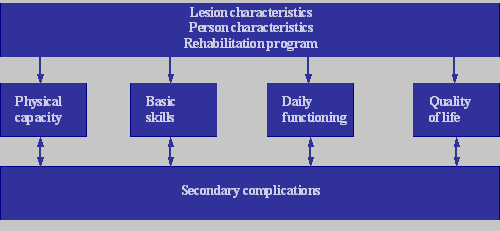Manual wheelchair skill performance of persons with spinal cord injuries
- Olga Kilkens, MsC (Researcher)
- Lucas van der Woude, PhD (Program Supervision)
- Marcel Post, PhD (Project leader)
- Annet Dallmeijer, PhD
- Floris van Asbeck, MD, PhD
- Anand Nene, MD, PhD
- Edmond Angenot, MD
On April 1, 2005, Olga Kilkens defended her dissertation entitled: Manual wheelchair skill performance of persons with spinal cord injuries
Summary
The majority of persons with spinal cord injuries (SCI) will be dependent on a manual wheelchair for their mobility for the rest of their lives. The mastering of wheelchair skills will enhance their independence and participation in daily life, and the actual training of these skills therefore is a vital part of the inpatient rehabilitation process. Although wheelchair skill performance is seen as an important aspect for independent mobility, daily functioning, and participation, there is only little known about the development of wheelchair skill performance in persons with SCI during and after inpatient rehabilitation. Thereby, only little insight exists in the longitudinal relationship between manual wheelchair skill performance and personal- and lesion characteristics, secondary complications, and physical capacity during inpatient rehabilitation. The association between manual wheelchair skill performance and participation in persons with SCI has also never been studied. Enlarging our knowledge of the development of wheelchair skills is important since it may influence the rehabilitation treatment process, and the treatment goals, which are set during rehabilitation. Moreover it may be used to optimize the process of learning wheelchair skill performance, and to enhance participation after discharge from inpatient rehabilitation. In the present study, a functional test was developed to assess wheelchair skill performance in persons with SCI: the Wheelchair Circuit. The Wheelchair Circuit consists of 8 standardized tasks: figure-of-eight shape, crossing a doorstep, mounting a platform, 15m sprint, negotiating a 3- and a 6% slope, 3 minute wheelchair propulsion, and finally performing a transfer. The performance of the Wheelchair Circuit leads to three different test scores: ability score, performance time score, and physical strain score.
Aims and research questions
The primary aims of the present study are 1) to assess the clinimetric qualities of the Wheelchair Circuit, 2) to evaluate the development of manual wheelchair skill performance during the inpatient rehabilitation of persons with SCI, and to identify factors that affect this process, and 3) to study the relationship between manual wheelchair skill performance and participation in persons with SCI after discharge from inpatient rehabilitation.
The main research questions of this thesis are:
- Is the Wheelchair Circuit a reliable, valid and responsive test to assess wheelchair skill performance?
- How does manual wheelchair skill performance develop during inpatient rehabilitation of persons with acute SCI?
- Is the development of manual wheelchair skill performance related to personal- and lesion characteristics, secondary complications, and physical capacity?
- Is there a relationship between manual wheelchair skill performance and participation in persons with SCI, 1-year after discharge from clinical rehabilitation.
Schematic view of the outcome

Results
Chapter 2 reports on a systematic review of wheelchair skills tests that are available in the literature. The search resulted in 24 different wheelchair skills tests that showed large variation in the skills that were included, and the outcome measures that were used. The clinimetric properties of only two tests were adequately investigated. The main conclusion of the review was that, at the start of this study, there was no standard test to measure wheelchair skill performance.
In Chapter 3 the Wheelchair Circuit, the test to assess manual wheelchair skill performance that was developed in this study is described, and the reliability of the Wheelchair Circuit is investigated. A convenience sample of persons with SCI, who were all in the final stage of their inpatient rehabilitation, performed the Wheelchair Circuit on three different occasions, and the measurements were conducted by two different raters. The results showed that the overall inter- and Intra-rater reliability of the Wheelchair Circuit is good.
Chapter 4 demonstrates that the Wheelchair Circuit is a valid and responsive instrument for measuring manual wheelchair mobility in persons with SCI.
Chapter 5 illustrates that during inpatient SCI rehabilitation the scores of the Wheelchair Circuit significantly improve, with the largest improvement occurring during the first three months. The development of wheelchair skill performance is significantly influenced by age and lesion level. Older persons and persons with tetraplegia have lower scores on the Wheelchair Circuit than younger persons and persons with paraplegia. Age and Body Mass Index (BMI) are the most important variables to predict the scores of the Wheelchair Circuit at the time of discharge. At the end of their inpatient rehabilitation, older persons, and persons with a higher BMI will have lower scores on the Wheelchair Circuit than younger persons and persons with a lower BMI.
Chapter 6 shows that upper extremity muscle force and peak power output are important parameters for the development of wheelchair skill performance during inpatient rehabilitation. Persons with higher upper extremity muscle force and higher peak power output will have higher scores on the Wheelchair Circuit than persons with lower upper extremity muscle force and lower peak power output.
Chapter 7 shows that in persons with SCI, one year after discharge from inpatient rehabilitation, manual wheelchair skill performance is positively related to participation. This association remains significant when demographic variables and lesion characteristics are taken into account. In this study participation was assessed with the social dimension of the 68-item Sickness Impact Profile (SIP68).
Conclusions and recommendations
The Wheelchair Circuit is a reliable, valid and responsive instrument to assess manual wheelchair mobility in persons with SCI. The Wheelchair Circuit is a compact measurement, which is convenient to perform. The scoring system is uncomplicated, easy to interpret, and provides information on several aspects of wheelchair skill performance. During the Inpatient rehabilitation, older persons and persons with tetraplegia reach a lower level of wheelchair skill performance than younger persons and persons with paraplegia. In future research it can be investigated whether increasing the duration and/or frequency of wheelchair skill training in older persons and in persons with a tetraplegia is useful to reduce the adverse position these persons have concerning wheelchair skill performance. There is a positive relation between the development of wheelchair skill performance, peak power output, and upper body muscle strength during the rehabilitation of persons with SCI. From this it is concluded that, in order to optimize the development of wheelchair skill performance, attention should be directed towards manual wheelchair exercise training and strength training of the upper body muscle groups.
In persons with SCI, manual wheelchair skill performance is positively associated to participation one year after discharge from inpatient rehabilitation. To stimulate the level of participation after discharge it is important to pay extra attention to training and therapy aimed at achieving an optimal level of wheelchair skill performance during the inpatient rehabilitation period. Furthermore, persons should be stimulated to maintain their wheelchair skills after discharge from inpatient rehabilitation.
Publications from this thesis
- Wheelchair Skills tests: a systematic review. Kilkens O, Post M, Seelen HAM, Dallmeijer AJ, van der Woude LHV. Clinical Rehabilitation, 17: 418-430, 2003.
- The wheelchair circuit: reliability of a test to assess mobility in persons with spinal cord injuries. Kilkens O, Post MWM, van der Woude LHV, Dallmeijer AJ, van den Heuvel WJA, Archives Phys Med Rehabil, 83(12): 1783-1788, 2002.
- The wheelchair circuit: construct validity and responsiveness of a test to assess manual wheelchair mobility in persons with spinal cord injuries. Kilkens O, Post M, van der Woude LHV, Dallmeijer AJ, van den Heuvel WJA. Archives Phys Med Rehabil, 85(3): 424-31, 2004.
- Subject- and injury-related factors influencing the course of manual wheelchair skill performance during initial inpatient rehabilitation of persons with a spinal cord injury. Kilkens OJ, Dallmeijer AJ, Angenot E, Twisk J, Post MW, van der Woude LHV. Arch Phys Med Rehabil 86(11): 2119-25, 2005.
- Relationship between manual wheelchair skill performance and participation of persons with spinal cord injuries 1 year after discharge from inpatient rehabilitation. Kilkens OJ, van der Woude LHV, Dallmeijer AJ, Nene AV, Post MW. JRRD 42(3 suppl 1): 65-73, 2005.
- The longitudinal relation between physical capacity and wheelchair skill performance during inpatient rehabilitation of people with spinal cord injury. Kilkens OJ, Dallmeijer AJ, Nene AV, Post MW, van der Woude LH. Arch Phys Med Rehabil, 86(8): 1575-81, 2005.





